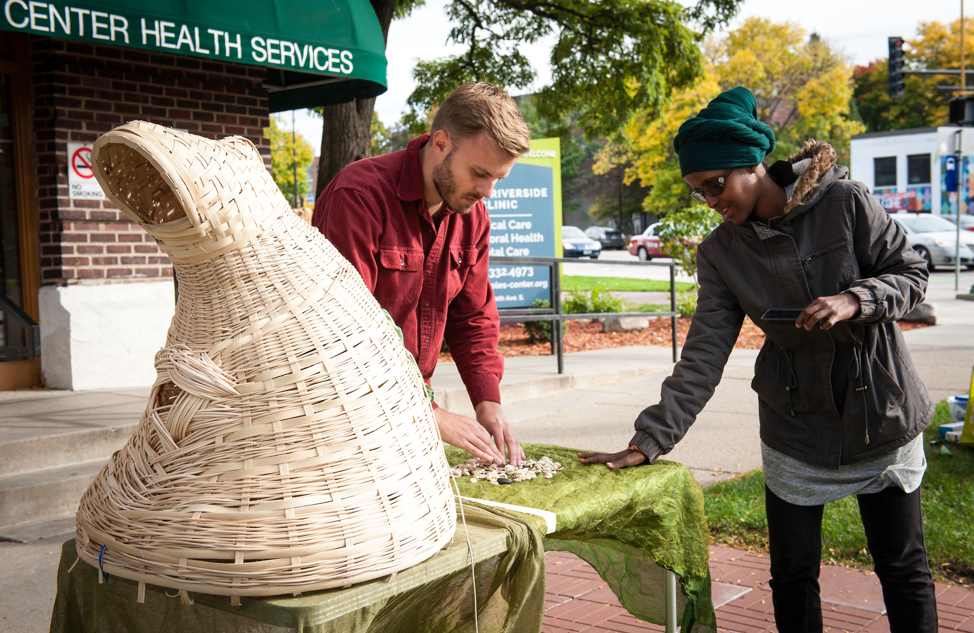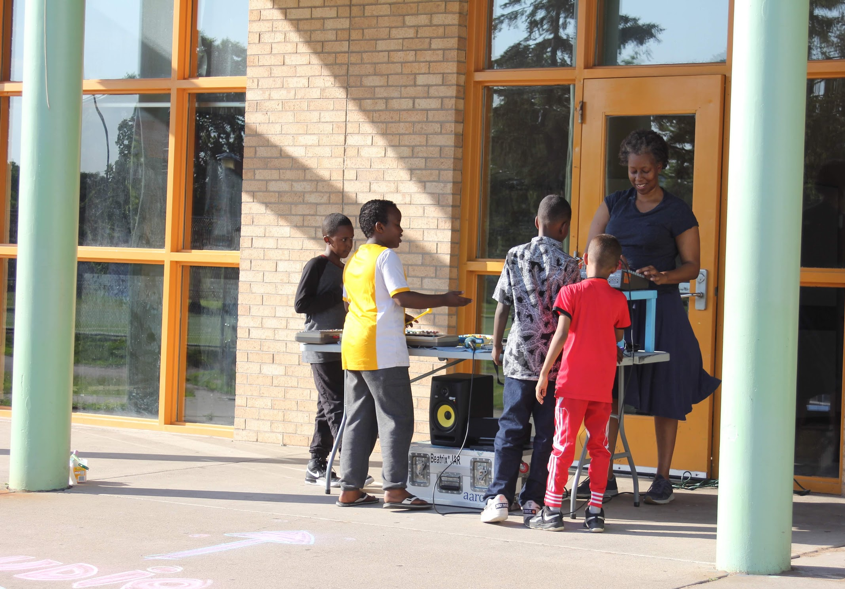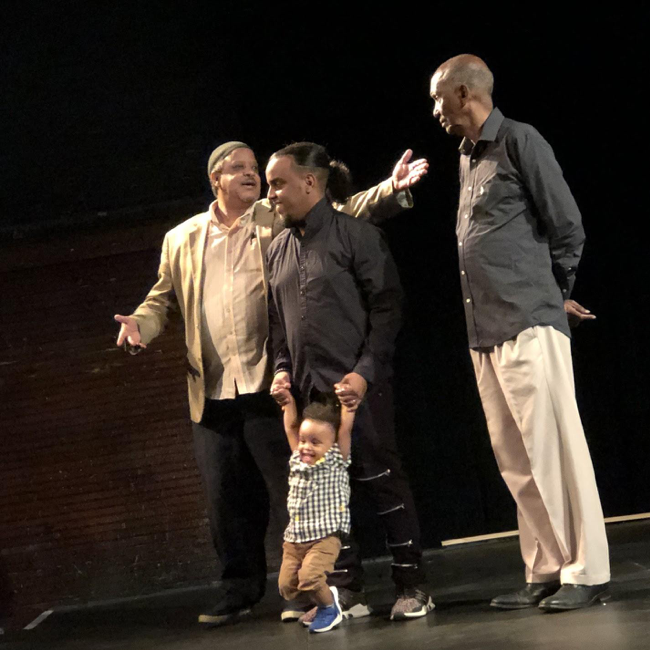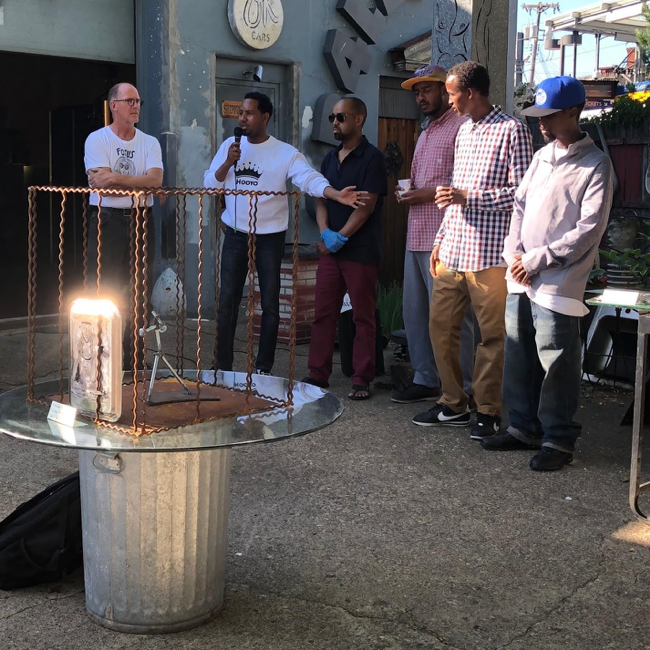Connecting Community in Cedar-Riverside
Jamie Schumacher is the Executive Director of the West Bank Business Association, a partner with Springboard for the Arts and People’s Center Health Services on connecting and celebrating the Cedar-Riverside community on the West Bank, Minneapolis. The creative activities featured in this article are part of a larger project to promote cross-cultural connection and understanding between neighbors of different cultures and backgrounds to combat Islamophobia. Funding is provided by the Doris Duke Foundation for Islamic Arts’ Building Bridges Grants Program, The Kresge Foundation and Bush Foundation.
The West Bank/Cedar-Riverside neighborhood of Minneapolis is unlike any other place in the world. One of the highest density areas in the Midwest, our diverse neighborhood has roots and connections that span the globe, particularly East Africa and Somalia. Rich with community, art, culture, and representation from many faiths, the West Bank is also the home of Minnesota’s first Somali-run Mosque: Dar al-Hijrah Islamic Civic Center. The Riverside Plaza apartment high-rises, Ralph Rapson-designed brutalist-style architectural icons for our neighborhood, serve as the backdrop to Currie Park, one of only a few green spaces among a densely populated urban landscape. Older children from the neighborhood play soccer in the fields late into the evening while parents, grandparents, aunties, and uncles border the playground to keep a watchful eye over younger siblings.
For many, Cedar Avenue is the center point of the neighborhood – a commercial corridor where 200 businesses connect, most of them still locally owned and operated. Theaters, venues, shops, bars, and restaurants boast outdoor patios, hand-painted signs, and sandwich boards to welcome potential customers – immediate neighbors and visitors from farther afield.

Springboard for the Arts and People’s Center Health Services, housed in the West Bank, have a longstanding relationship based on helping artists access affordable healthcare for the past ten years. Over time, that relationship expanded to bringing artist-led activities to the People’s Center to encourage interaction, spark dialogue, and create moments of play. In 2018, Springboard for the Arts hosted pop-up art events at People’s Center for patients and their families coming in for routine care to participate in creative activities on their way to appointments or while they waited to be called. Clinic staff on breaks and passers-by were encouraged to join the activities as well. The novel activities provided an outlet for casual conversations about health and social connection, while also drawing awareness to the clinic and its services.
Some activities were designed specifically to support holistic health, such as “Healing Hands” by artist Ifrah Mansour. Ifrah created an activity featuring a signature woven hut, made using traditional weaving techniques, that invited users to create a temporary work of art that could be discussed. The contemplative and creative process could act as a boost to the participant’s healing and wellness.
Supporting Creative Collaborations
In 2019, while the People’s Center was in a leadership transition, the West Bank Business Association stepped in to continue building cross-cultural connections through creative artist-led projects, taking them beyond the boundaries of the People’s Center and into other parts of the neighborhood. The West Bank Business Association is a nonprofit that serves local businesses through marketing, technical assistance, and regional policy work. Abdurrahman Mahmud joined our team as a project coordinator, helping facilitate the projects that transpired.
When announcing the project collaborations, Laura Zabel, Executive Director of Springboard for the Arts said, “We are excited to support and amplify the creative people power that exists in Cedar-Riverside. These activities created by and for community members will build new connections, bridge cultures and help us imagine new possibilities.”
A winter workshop connected people in the community, including artists, on mutual interests and topics of urgency in the neighborhood. With the goal of using art and creative activities to build cross-cultural connections, the newly-formed groups worked together on their projects over the following months. While some individuals in groups knew one another, many had never worked together before at all. Over the next months, they grew to know one another quite well.

West Bank Get Together
The first project to launch was the West Bank Get Together – a celebration of music and beautification of the neighborhood. Minneapolis musicians Beatrix*JAR (Bianca Pettis and Jacob Aaron Roske) worked with Abdirahzak Bihi, resident and community leader, to coordinate a series of cleanups followed by music-making. Some of the cleanups commenced during Ramadan, which worked well for the cleanup efforts that took place following Friday prayers. Even one of the local Imams joined the group to help pick up trash from a heavily used pathway that cuts between two buildings. Following the clean-ups, the group led a musical activity “The Audio Playground” at Currie Park. Children at the park meandered over one by one to play on the electronic equipment, gleefully filling the park with boisterous and dissident electronic sounds with help from the sound artists. Bringing people together to care for their neighborhood and connect to one another while cleaning and playing strengthened bonds in new ways.
Feynuus Lighting Project
“Feynuus” is the Somali word for “lantern,” usually a gas light used in Somalia to add brightness and warmth to homes that is still used today. Drawing attention to the need for additional lighting in darkened areas of the neighborhood, a group of mothers hosted a Feynuus lighting ceremony after dusk on a Friday evening. This quiet event brought warmth and light to an otherwise dark corner of the park and served to highlight to the city and other powers-that-be the great need to increase the lighting in the area, especially the dark corners that surround the park where children play. In the words of a member of the team, the Feynuus project “brought the culture of the Somali people to the streets of Cedar-Riverside. It created more life to the dark alleys of Cedar-Riverside neighborhood.” This project also helped the mothers group envisioned a larger permanent lighting plan that can be used in the future to address the real need.
In a final project reflection, one of the organizing mothers said “These light structures made the people of Cedar-Riverside Neighborhood feel they have a standing position in the neighborhood. It taught the youth that they should be proud of their heritage and themselves. It taught me that you could teach people about themselves and to others not directly, but action and light fixtures. Learning in a fun and unique way.”

West Bank 6
Storytelling is an integral part of Somali culture, and one of the collaborations was a documentary that carried forward that tradition. Local filmmaker and spoken word artist Sisco Omar worked with youth and elders in the community on “West Bank 6 Story Film Display” to “change the bad perceptions of our community because the news that usually comes out of this neighborhood is bad and mostly not even associated with this neighborhood.” The documentary film project interviewed youth and elders from the neighborhood about everyday life to share a range of perspectives and stories. For instance, parent Abdullahi Sheikh, shared his thoughts on raising children, proposing they don’t belong to a single parent, but to the whole community. He exhorts to us it is with this type of inclusive and holistic care in mind we must love our children. Artist Khadra Fiqi’s interview reminded us about the realities of process to accomplish a goal – that the process can be long, but don’t let that discourage you! You need to be patient, bold, and committed to the work. While the short timeframe for the project limited the number of interviews Sisco could do, he has hopes to expand the project and broadcast it online.

Hope Through Art
Hope Through Art, a combined mentorship and gallery showing, connected business owners and youth from the neighborhood. Artist Allen Christian runs the House of Balls gallery, an Atlas Obscura-featured wonderland of large and small scale sculptures made and machined from recycled and repurposed materials. Over the course of several months Allen worked with local youth through the Daryeel Youth volunteer team from the neighborhood, mentoring them in welding, metal sculpture, and expression through art. The apprenticeship culminated with gallery opening featuring the work of the young men, on display before an admiring crowd of community members and art-lovers alike.
One of the youth participants said “I really don’t have too much art in my background, that’s something I always wanted to learn. When I get older and have my own house and get a garage, I’ll just start welding things, start putting art together – probably open a spot like House of Balls for the future, probably help other kids like [Allen Christian] helped us.”
Allen said about his experience “It’s been humbling for me to find out how much they’ve gone through at such an early age. I’m also finding out how much it means for them to be respected, acknowledged, and given responsibility. It’s been a win-win for all of us.”
In a neighborhood built on continual change, what holds everything together?
“Art lets us imagine and build other worlds. We have the imagination to create them, and the skill set to build them. ART gives us that,” notes theater director Mark Valdez, who has worked on the West Bank at Mixed Blood Theatre.
When the organizers set out to do this work, we didn’t set out to create community on the West Bank, because a great community is already here. What we hoped to do was to create opportunities for people to connect across cultures and for relationships to grow by working on and encountering one another through creative activities. “Because these were creative projects, it made a difference in the outcome. I think, because it was art, people can connect over that. People have a connection point,” organizer Abdurrahman Mahmud noted, reflecting on the projects. “Helping with the organization was good. The groups were able to then focus on their projects, and their art.”
And indeed they did. But more than art was created, new relationships were forged as well.
Sam Buffington, Community Organizer with Springboard for the Arts, said, “We invited teams to create projects that would bring people together from different cultures, and by doing something together – whether cleaning alleys, making music, sharing stories or learning welding – we found that people connected, forged new ideas and started new relationships. These bonds between people that begin to break down barriers across languages, cultures and stereotypes are exactly what we hope to achieve through this work.”
Art is a beautiful thing. It can communicate concepts without words, bridging the boundary of language, generations, cultures, and even geography. And in a neighborhood where there is so much ebb and flow, art is a fluid, natural way to connect.
Art is also a way relationship-building and creative collaboration can happen naturally, transcending barriers both real and perceived. Some of the projects in this process will continue as additional lights are installed throughout the neighborhood, and as the WestBank6 documentary adds stories to its collection. But perhaps more importantly, relationships forged in the process that will continue on. To help build and foster cross-cultural connections in the neighborhood, People’s Center Clinics and Services recently hired an Artist Organizer, Nimo Farah. New mentorships are forming, new ideas are blossoming, and with them the promise of new projects, and new relationships.
Cover photo: Feynuus Lighting, Bosteya Jama, Halima Hassan, and Fartun Del. Photograph by Siyad Salah.
